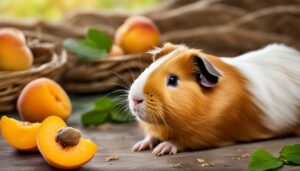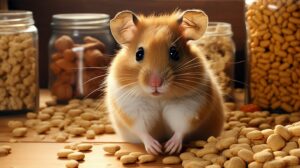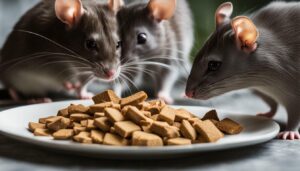Hamsters are popular pets, but many owners wonder if it is safe to feed them cheese. While cheese is not toxic to hamsters, it should be given sparingly due to its calorie-dense and high-fat nature. It’s important to understand the dietary needs of hamsters and make informed decisions when it comes to their nutrition.
- Cheese can be given to hamsters, but it should be served in moderation.
- Some types of cheese, such as asiago, cheddar, and parmesan, should be avoided due to their high sodium levels.
- Cottage cheese, especially the low-fat variety, is a safer option for hamsters as it is low in calories and rich in protein and calcium.
- It’s important to monitor your hamster’s intake of cheese and their dental health.
- Not all hamsters may enjoy eating cheese, so observe their preferences and provide alternative snacks if needed.
Understanding Hamsters’ Dietary Needs
Before we dive into whether hamsters can eat cheese, it’s important to understand their dietary needs. Hamsters are omnivorous animals and require a balanced diet to ensure their health and well-being. Their diet should consist of a variety of fresh fruits, vegetables, grains, and proteins.
Hamsters have specific dietary requirements that should be met to prevent nutritional deficiencies or health issues. They need a diet that is low in fat and sugar, high in fiber, and rich in vitamins and minerals. It’s important to provide them with a diet that closely mimics their natural food sources, which include seeds, nuts, and insects.
When it comes to dairy products, hamsters are lactose intolerant. This means that they have difficulty digesting lactose, the sugar found in milk and other dairy products. While hamsters can consume small amounts of dairy, it’s best to avoid giving them regular milk or high-fat dairy products.
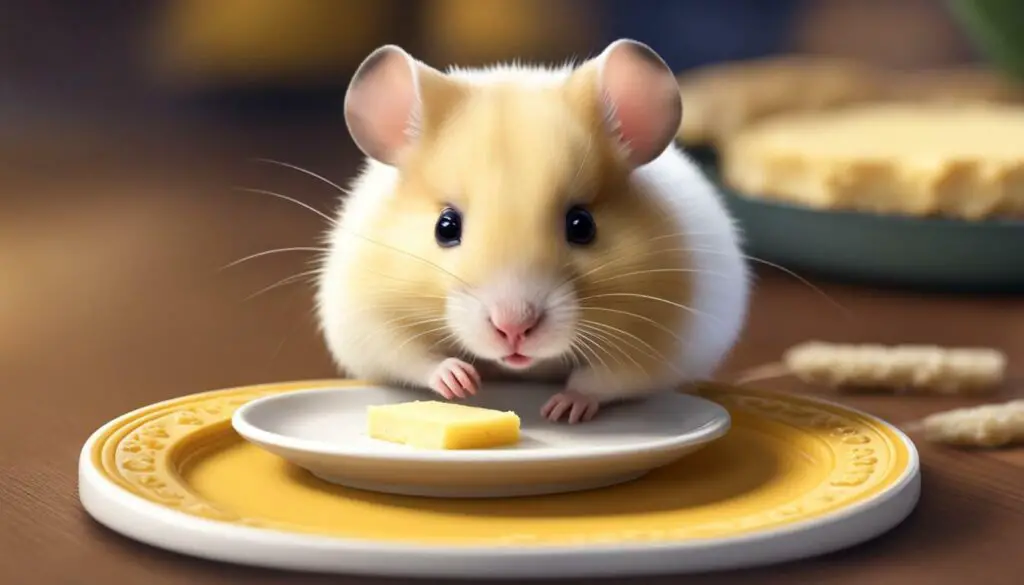
Protein is an essential nutrient for hamsters as it helps support their growth, development, and overall health. While cheese is a source of protein, it should be given sparingly due to its high fat content. Instead, opt for leaner sources of protein such as cooked chicken, boiled eggs, or tofu.
Calcium is another important nutrient for hamsters, especially for their bone health. While cheese does contain calcium, it is best to provide them with calcium-rich foods that are low in fat, such as broccoli, kale, or spinach.
In summary, hamsters have specific dietary needs that should be met to ensure their health and well-being. While they can eat cheese, it should be given sparingly due to its high fat content. Cottage cheese, especially the low-fat variety, is a safer option for hamsters as it is low in calories and rich in protein and calcium. Remember to serve cheese in moderation, preferably once a week, and remove any uneaten cheese to prevent rotting. It’s important to monitor your hamster’s intake and dental health, and provide alternative snacks if they do not enjoy or tolerate cheese well.
The Risks of Feeding Hamsters Cheese
While hamsters can technically eat cheese, it’s important to be aware of the potential risks it poses to their health. Cheese is calorie-dense and high in fat, which can lead to obesity and diabetes in hamsters if consumed in large quantities. Additionally, certain types of cheese should be avoided due to their high sodium levels, such as asiago, cheddar, and parmesan. Excessive sodium intake can be harmful to a hamster’s overall well-being.
To better understand the risks associated with feeding hamsters cheese, it’s essential to consider the fat and calorie content of different cheese varieties. For example, cheddar cheese contains around 400 calories per 100 grams, making it a high-calorie option for hamsters. This can easily contribute to weight gain and related health issues. Similarly, cheese with high fat content can put strain on a hamster’s digestive system and lead to digestive problems.
It’s crucial to remember that hamsters have specific dietary needs that must be met for them to thrive. While cheese can be given as an occasional treat, it should not make up a significant portion of their diet. Instead, consider incorporating other safe and nutritious snacks into their daily meals. This will ensure a more balanced and varied diet, providing the necessary nutrients without the associated risks of excessive cheese consumption.
The Risks of Feeding Hamsters Cheese: Summary
| Type of Risk | Explanation |
|---|---|
| Calorie-dense and high in fat | Cheese can contribute to obesity and diabetes in hamsters. |
| High sodium levels | Certain types of cheese, like asiago, cheddar, and parmesan, should be avoided due to their high sodium content. |
| Digestive issues | Excessive fat intake can strain a hamster’s digestive system and lead to digestive problems. |
It’s important to prioritize your hamster’s overall health and well-being by providing a balanced and appropriate diet. While cheese can be offered as an occasional treat, it should not be a staple in their daily meals. By understanding the risks associated with feeding hamsters cheese, you can make informed decisions about their diet and ensure they lead a long and healthy life.
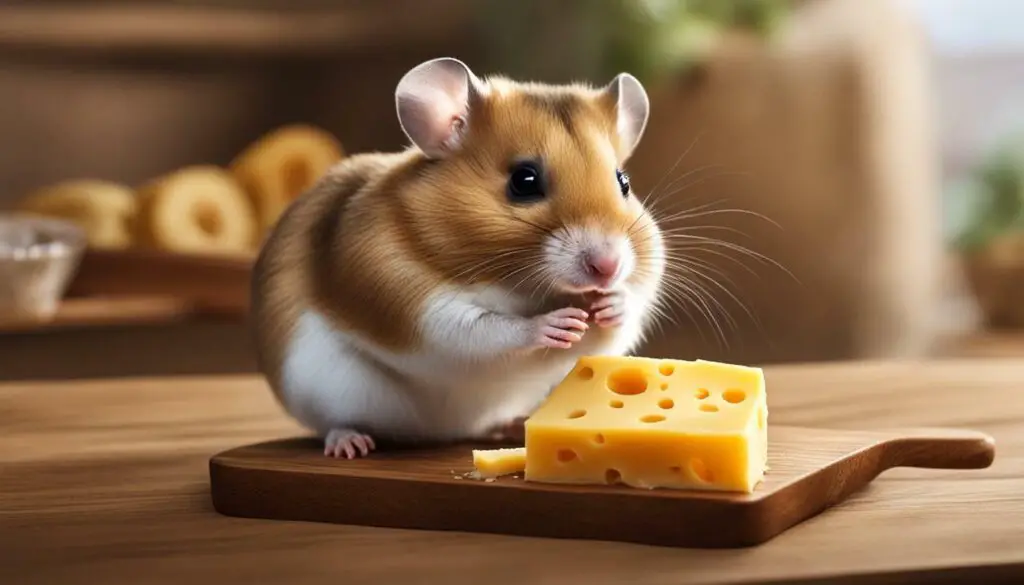
“A hamster’s diet should consist of a variety of fresh fruits, vegetables, and high-quality hamster pellets. These foods provide the essential nutrients and vitamins necessary for their growth and development. While it may be tempting to offer cheese as a treat, it’s important to do so in moderation and consider the potential risks involved.”
By implementing a balanced and varied diet for your hamster, you can provide them with the necessary nutrition while minimizing the potential risks associated with feeding them cheese. Remember to monitor their intake, ensure dental health, and observe their preferences to create a healthy and enjoyable eating experience for your furry friend.
Types of Cheese to Avoid
Not all cheeses are created equal when it comes to hamster consumption. While cheese is not toxic to hamsters, certain types should be avoided due to their high sodium levels. Asiago, cheddar, and parmesan are examples of cheeses that should not be fed to your furry friend. These cheeses often contain excessive amounts of sodium, which can be harmful to hamsters.
Hamsters have small bodies and delicate systems, making them more susceptible to the negative effects of high sodium intake. Too much sodium can lead to dehydration, kidney problems, and other health issues. It’s important to keep an eye on your hamster’s sodium intake and choose cheeses that are low in sodium.
Instead of these high-sodium cheeses, consider offering your hamster cottage cheese. Cottage cheese, especially the low-fat variety, is a healthier option for hamsters. It is low in calories, rich in protein, and contains beneficial calcium. In moderation, cottage cheese can be a safe and nutritious addition to your hamster’s diet.
| Cheese Type | Sodium Content (per 100g) |
|---|---|
| Asiago | 1200mg |
| Cheddar | 600mg |
| Parmesan | 1600mg |
Remember, moderation is key when it comes to feeding cheese to your hamster. It is recommended to serve cheese as a treat no more than once a week. Additionally, any uneaten cheese should be promptly removed from your hamster’s cage to prevent it from rotting and causing health issues.
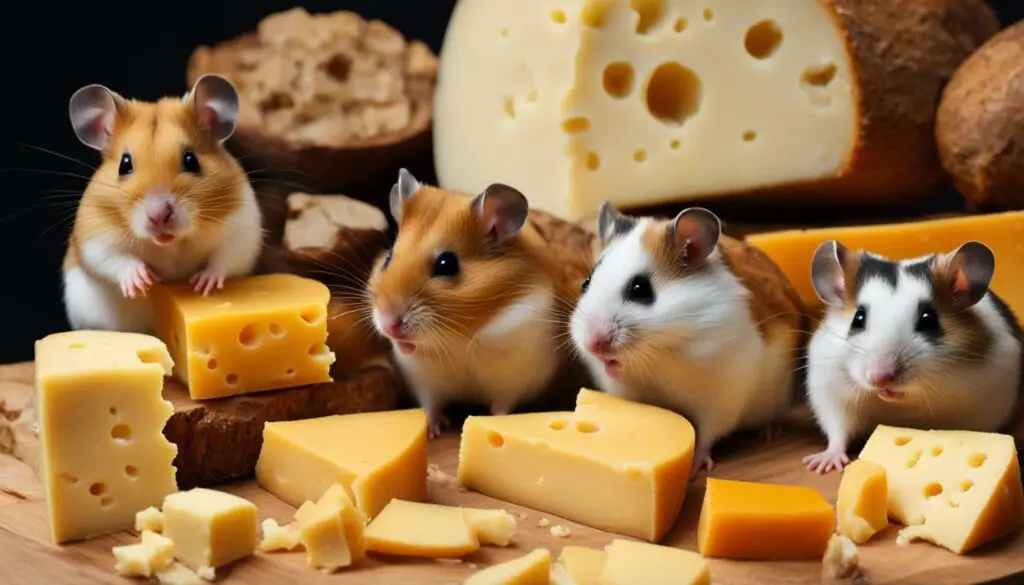
While some hamsters may enjoy the occasional cheese snack, it’s important to note that not all hamsters may have a taste for cheese. Just like humans, hamsters have their own preferences when it comes to food. If your furry friend shows little interest in cheese, there’s no need to force it. There are plenty of other healthy snacks available for hamsters to enjoy.
Hamster Diet Do’s and Don’ts
- Do: Serve cheese in moderation, preferably once a week.
- Do: Opt for low-sodium cheeses like cottage cheese.
- Do: Monitor your hamster’s intake and remove any uneaten cheese.
- Don’t: Feed hamsters high-sodium cheeses like asiago, cheddar, or parmesan.
- Don’t: Overindulge your hamster with cheese, as it is calorie-dense and high in fat.
“Feeding your hamster cheese can be a fun and tasty treat, but it’s important to choose the right types and offer them in moderation. Always prioritize your hamster’s health and well-being when deciding on their diet.”
Safe Cheese Options for Hamsters
While some cheeses may be risky for hamsters, there are safe options available. When it comes to feeding hamsters cheese, it’s important to choose varieties that are low in fat, calories, and sodium. One such option is cottage cheese, particularly the low-fat variety. Cottage cheese is not only low in calories but also rich in protein and calcium, which are essential for a hamster’s overall health.
Incorporating cottage cheese into your hamster’s diet can provide them with a tasty and nutritious snack. However, it’s essential to serve cheese in moderation. Too much cheese can lead to weight gain and health issues. Ideally, cheese should be given to your hamster once a week as a treat, rather than a regular part of their daily diet.
To ensure your hamster’s well-being, it’s important to monitor their cheese intake and dental health. Hamsters can be prone to dental problems, so it’s crucial to observe their eating habits and check their teeth regularly. Remove any uneaten cheese from their enclosure to prevent it from spoiling and causing potential health issues.
| Cheese Types | Description |
|---|---|
| Low-Fat Cottage Cheese | A safe and nutritious option for hamsters, low-fat cottage cheese is low in calories and rich in protein and calcium. |
| Avoid These Cheeses | Asiago, cheddar, and parmesan should be avoided due to their high sodium levels, which can be harmful to hamsters. |
Remember, not all hamsters may enjoy eating cheese. If your furry friend shows no interest in cheese or doesn’t seem to enjoy it, there’s no need to force it. There are plenty of other healthy snack options available for hamsters, such as fresh fruits and vegetables.
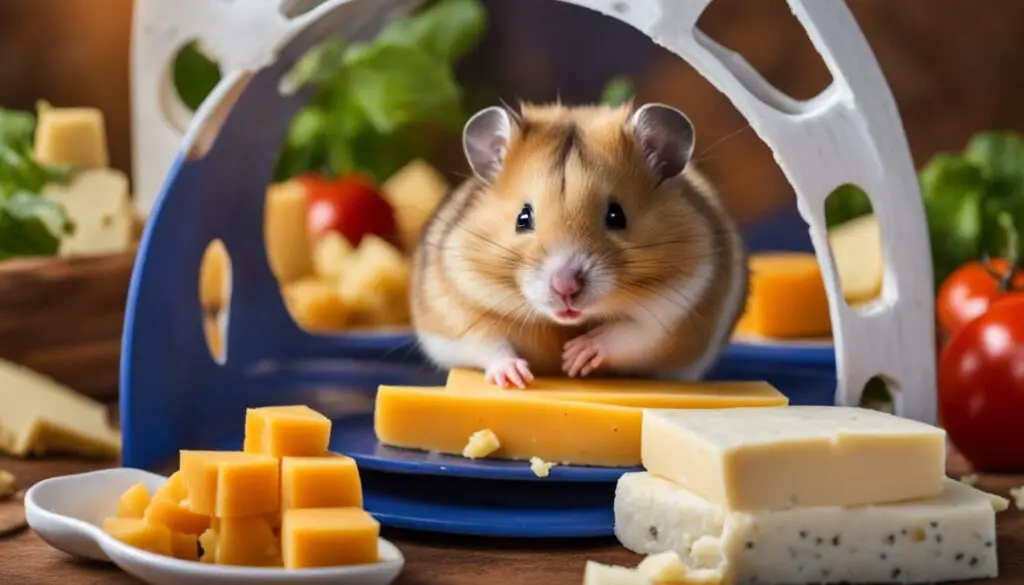
When considering your hamster’s overall diet, it’s important to provide a balanced and varied range of foods. Cheese should only be a small part of their diet, alongside other essential hamster food items such as pellets, fresh water, and hay. By offering a diverse array of foods, you can ensure that your hamster receives all the necessary nutrients for a happy and healthy life.
Moderation is Key
Like with most treats, moderation is key when it comes to feeding hamsters cheese. While hamsters can eat cheese, it should be given sparingly due to its high calorie and fat content. Cheese is not toxic to hamsters, but it can contribute to health issues such as obesity and diabetes if consumed in excess.
When offering cheese to your hamster, it is important to choose the right type. Certain cheeses, such as asiago, cheddar, and parmesan, should be avoided due to their high sodium levels. Instead, opt for low-fat cottage cheese, which is low in calories and rich in protein and calcium. This makes it a healthier option for your furry friend.
It’s recommended to serve cheese to your hamster in moderation, ideally once a week. This helps to prevent overconsumption and ensures a balanced diet. Additionally, any uneaten cheese should be promptly removed from their cage to prevent it from rotting and causing health issues.
As with any food, it’s important to monitor your hamster’s intake and dental health. Cheese can be a sticky food, which can potentially cause dental problems if not properly cleaned. Regularly observe your hamster’s eating habits and check their teeth to ensure they are in good condition.
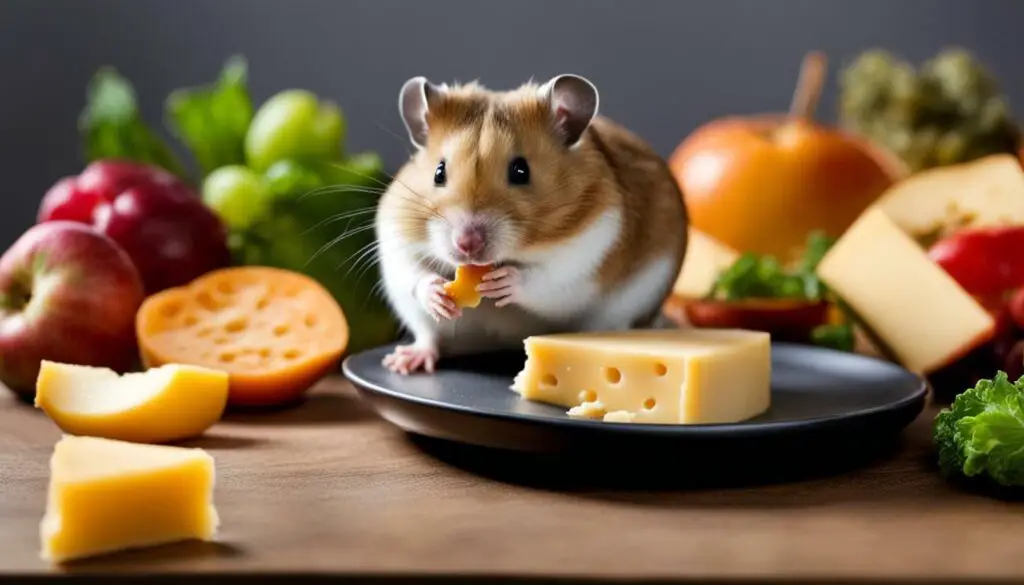
It’s worth noting that not all hamsters may enjoy eating cheese. Just like humans, hamsters have their own preferences when it comes to food. If your hamster shows no interest in cheese, there’s no need to force it. Instead, provide alternative healthy snacks that appeal to their taste.
In conclusion, while hamsters can enjoy a small amount of cheese as a treat, it’s important to prioritize their overall diet and health. Moderation, careful selection of cheese types, and regular monitoring of intake are key to ensuring your hamster maintains a balanced and nutritious lifestyle.
Monitoring Intake and Dental Health
It’s crucial to keep an eye on your hamster’s cheese consumption and ensure their dental health is maintained. While cheese can be a tasty treat for hamsters, it should only be given in moderation due to its high fat and calorie content. Obesity and diabetes are serious health concerns for hamsters, and overfeeding them cheese can contribute to these issues.

When serving cheese to your hamster, it’s important to monitor their intake and remove any uneaten portions promptly. This helps prevent the cheese from rotting and causing digestive issues. Additionally, be aware that not all hamsters may enjoy eating cheese. Some may have preferences for other snacks or treats, so it’s essential to observe their reactions and provide alternative options if needed.
| Cheese Type | Notes |
|---|---|
| Asiago | Avoid – high sodium levels |
| Cheddar | Avoid – high sodium levels |
| Parmesan | Avoid – high sodium levels |
Safe cheese options for hamsters include cottage cheese, particularly the low-fat variety. Cottage cheese is low in calories and packed with protein and calcium, making it a healthier choice for your furry friend. Remember to serve cheese sparingly, ideally once a week, to avoid overconsumption and maintain a balanced diet for your hamster.
Keeping Your Hamster Healthy and Happy
- Monitor your hamster’s cheese intake and remove any uneaten portions promptly.
- Observe your hamster’s preferences and provide alternative snacks if they do not enjoy cheese.
- Choose low-fat cottage cheese as a safe and nutritious option.
- Serve cheese in moderation, ideally once a week.
- Maintain your hamster’s dental health by regularly checking their teeth for any signs of issues.
By following these guidelines and being mindful of your hamster’s overall diet, you can ensure they stay healthy and happy. Remember, moderation is key when it comes to feeding hamsters cheese, and their well-being should always be the top priority.
Not All Hamsters Like Cheese
While some hamsters may enjoy the occasional cheese treat, others may not be interested at all. Just like humans, hamsters have individual preferences and tastes when it comes to food. If your furry friend shows little to no interest in cheese, don’t be alarmed. There are plenty of other healthy and tasty snacks you can offer to keep them satisfied.
Hamsters are naturally omnivorous, which means their diet should consist of a variety of foods to meet their nutritional needs. While cheese can be a source of protein and calcium, it should only be given in moderation due to its high fat and calorie content. If your hamster does enjoy cheese, it’s important to choose the right type and serve it sparingly.
One safe and nutritious cheese option for hamsters is low-fat cottage cheese. This variety is low in calories and provides essential nutrients such as protein and calcium. Remember to introduce any new food gradually and monitor your hamster’s response. If they show signs of digestive discomfort or dislike, it’s best to offer alternative snacks.
| Cheese Type | Sodium Level |
|---|---|
| Asiago | High |
| Cheddar | High |
| Parmesan | High |
If you do decide to offer cheese to your hamster, avoid certain types that have high sodium levels like Asiago, Cheddar, and Parmesan. These cheeses can be detrimental to a hamster’s health and should be excluded from their diet. Always check labels and choose cheeses that are low in sodium to ensure your hamster’s well-being.
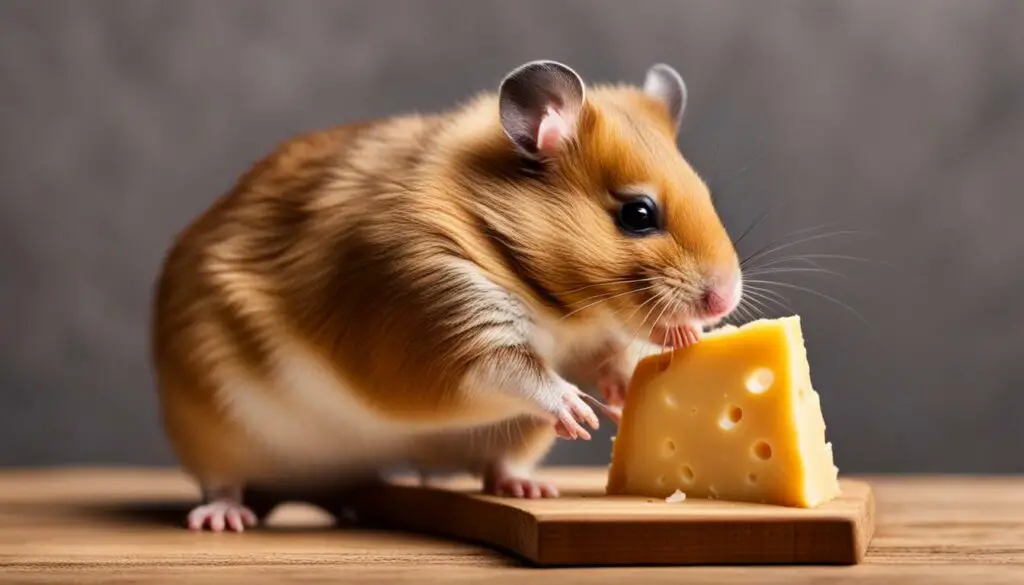
Remember, not all hamsters are the same, and it’s essential to respect their individual preferences and dietary needs. If your hamster doesn’t enjoy cheese or shows no interest, there are plenty of other healthy snack options available. Offer a variety of fresh fruits, vegetables, and hamster-safe treats to keep your little friend happy and nourished.
Removing Uneaten Cheese
If your hamster doesn’t finish their cheese, it’s important to remove it promptly to avoid any potential health issues. Cheese can spoil quickly, and consuming spoiled cheese can lead to digestive problems for your furry friend. Additionally, leaving uneaten cheese in their habitat can attract pests and create an unsanitary environment.
When you offer cheese as a snack to your hamster, it’s essential to observe their eating habits. Some hamsters may only nibble on a small portion and leave the rest untouched. If this happens, carefully remove the uneaten cheese from their enclosure using clean, sanitized tongs or utensils. Place the cheese in a sealed container and discard it in a proper trash receptacle.
While it’s important to provide your hamster with a varied diet, cheese should be given in moderation. It’s a high-calorie food and can contribute to weight gain if overfed. Remember, moderation is key to maintaining a healthy balance in your hamster’s diet.
| Cheese Alternatives for Hamsters |
|---|
| – Fresh fruits: Slice up small pieces of apple, pear, or banana as healthy alternatives to cheese. |
| – Vegetables: Offer small portions of baby carrots, broccoli florets, or sugar snap peas to add variety to your hamster’s diet. |
| – Seeds and nuts: Sprinkle a few sunflower seeds or pumpkin seeds into your hamster’s food bowl as a nutritious snack. |
| – Whole grains: Include small amounts of cooked whole grains, such as brown rice or quinoa, to provide fiber and nutrients. |
By incorporating these healthy snacks into your hamster’s diet and ensuring uneaten cheese is promptly removed, you can help maintain their overall health and well-being. Remember to consult with your veterinarian for specific dietary recommendations based on your hamster’s breed, age, and individual needs.
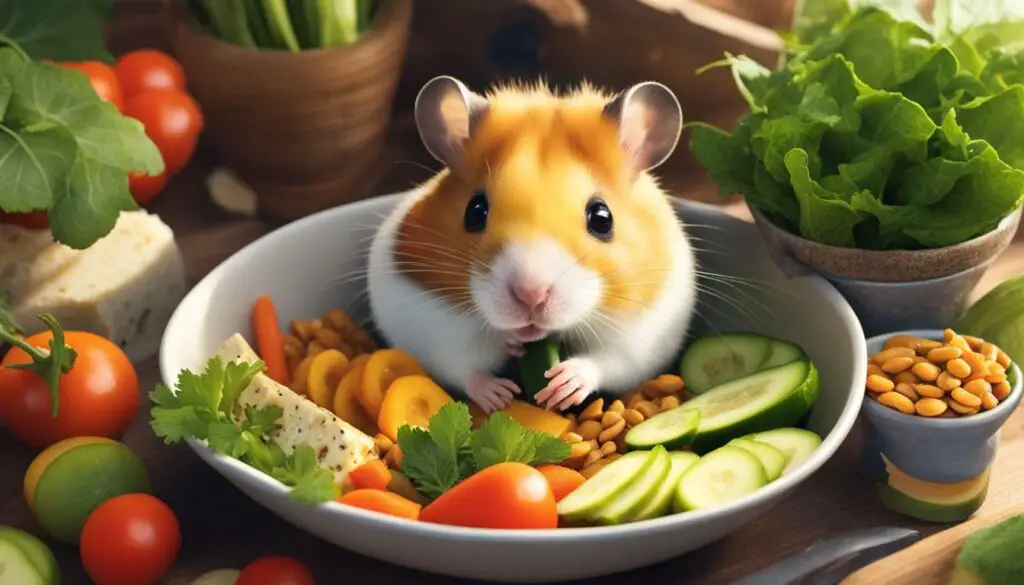
Cheese should be viewed as a small component of your hamster’s overall diet, which should consist of a variety of nutritious foods. While hamsters can eat cheese, it is important to offer it sparingly due to its high fat and calorie content. To ensure your hamster receives a well-balanced diet, it is crucial to incorporate a range of other foods that meet their nutritional needs.
A balanced hamster diet should primarily consist of a high-quality hamster pellet mix, which provides essential vitamins, minerals, and proteins. These pellets should make up the majority of your hamster’s daily food intake. Additionally, fresh fruits and vegetables should be offered daily to provide dietary fiber, antioxidants, and other essential nutrients. Examples of suitable fruits and vegetables for hamsters include apples, carrots, broccoli, and spinach.
It is also important to provide your hamster with a source of protein. In addition to cheese, hamsters can safely consume small amounts of cooked, plain chicken or turkey. This will help meet their protein needs without the high fat and calorie content found in cheese. Additionally, you can offer small amounts of cooked eggs or mealworms as occasional protein-rich treats.
| Food | Frequency | Serving Size |
|---|---|---|
| Hamster pellets | Daily | As recommended on packaging |
| Fresh fruits and vegetables | Daily | Small amount, about the size of a grape or cherry tomato |
| Plain chicken or turkey | Occasionally | Small amount, about the size of a fingertip |
| Cooked eggs or mealworms | Occasionally | Small amount, about the size of a pea |
Remember that water is essential for your hamster’s health, so always provide fresh, clean water in a water bottle or bowl. Avoid feeding your hamster excessive amounts of sugary or fatty foods, as these can lead to obesity and other health issues.
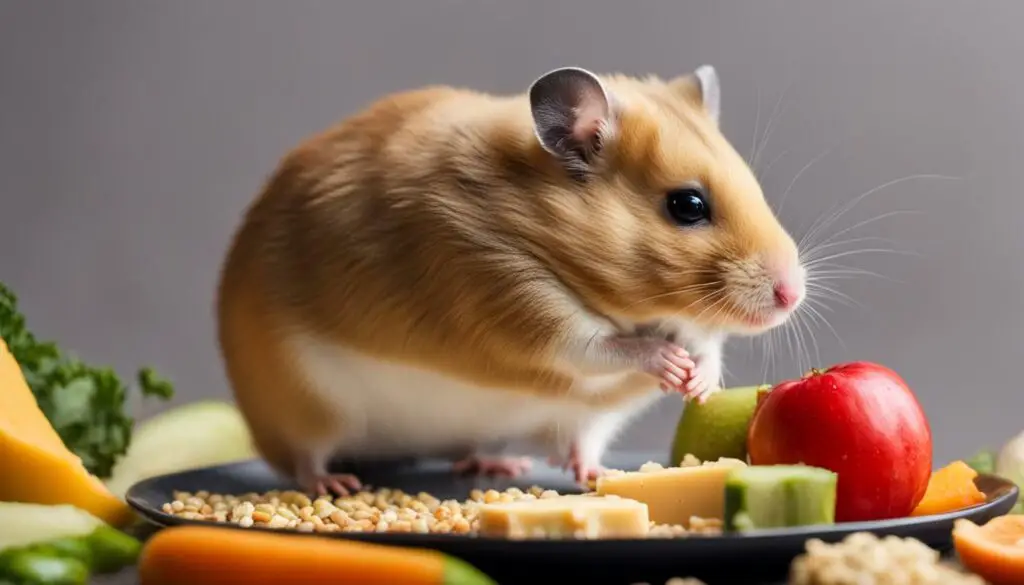
By considering your hamster’s overall diet and providing a wide range of nutritious foods, you can ensure they receive the necessary nutrients for optimal health. While cheese can be offered as an occasional treat, it should not be the main component of their diet. Monitor your hamster’s weight and overall well-being, and consult a veterinarian if you have any concerns about their dietary needs or health.
Conclusion
In conclusion, hamsters can eat cheese, but it should be given sparingly and with caution. While cheese is not toxic to hamsters, it is important to understand that it is calorie-dense and high in fat. Feeding hamsters excessive amounts of cheese can lead to obesity and diabetes, so moderation is key.
When it comes to the types of cheese that are safe for hamsters, it is best to avoid those with high sodium levels, such as asiago, cheddar, and parmesan. Instead, opt for cottage cheese, particularly the low-fat variety. Cottage cheese is a healthier option as it is low in calories and rich in protein and calcium, which are essential for a hamster’s overall well-being.
It is recommended to serve cheese to your hamster in moderation, ideally once a week. This ensures that they receive the nutritional benefits without any adverse effects. Additionally, it is crucial to remove any uneaten cheese from their enclosure to prevent it from rotting and causing potential health issues.
While some hamsters may enjoy cheese as a snack, it is important to remember that not all hamsters have the same preferences. If your hamster does not seem interested in cheese, there are plenty of other healthy snack options available. Observing your hamster’s eating habits and providing a varied diet is key to ensuring their overall health and well-being.
FAQ
Q: Can hamsters eat cheese?
A: Yes, hamsters can eat cheese, but it should be given sparingly.
Q: Is cheese toxic to hamsters?
A: No, cheese is not toxic to hamsters.
Q: Why should cheese be given sparingly to hamsters?
A: Cheese is calorie-dense and high in fat, so it can contribute to obesity and diabetes in hamsters.
Q: Are there certain types of cheese that should be avoided?
A: Yes, high-sodium cheeses such as asiago, cheddar, and parmesan should be avoided.
Q: What is a safe cheese option for hamsters?
A: Cottage cheese, especially the low-fat variety, is a good choice for hamsters as it is low in calories and rich in protein and calcium.
Q: How often should hamsters be given cheese?
A: Cheese should be served in moderation, preferably once a week.
Q: Why is it important to monitor a hamster’s intake and dental health?
A: Monitoring a hamster’s cheese intake can prevent overconsumption and related health issues. Regular dental health checks are important as well.
Q: Do all hamsters like cheese?
A: Not all hamsters may enjoy eating cheese. It is important to observe their preferences and provide alternative snacks if needed.
Q: Should uneaten cheese be removed?
A: Yes, any uneaten cheese should be removed to prevent it from rotting.
Q: How does cheese fit into a hamster’s overall diet?
A: Cheese should be considered as a treat and not a main part of a hamster’s diet. A balanced and varied diet is essential for meeting their nutritional needs.


